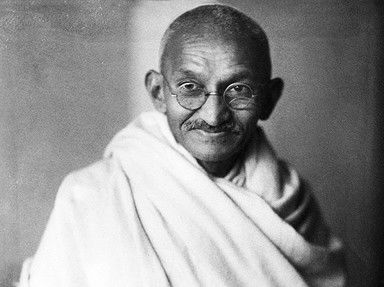Quiz Answer Key and Fun Facts
1. Looking to secure his family's future, a fresh-faced 18-year-old travelled overseas to earn his law degree. It wouldn't be easy, however, as his destination had plenty of meat and alcohol, two things he promised his mother he wouldn't partake in. Which city was it?
2. On legal assignment in South Africa in 1893, Gandhi was traveling on a train in a first-class compartment with a valid ticket provided to him by his client. A white passenger complained, which led to railway officials demanding he go to the third-class carriage. What happened next?
3. By 1906, Gandhi (pictured in the center) was an established lawyer known for his meticulous work. He started moving away from conventional legal work, wading into issues of systemic injustice. When the Asiatic Registration Act was passed, Gandhi led his first what, known in English as a nonviolent protest?
4. When Gandhi returned home to India in 1915, he had been overseas for over 20 years. He was invited to join what group by Gopal Krishna Gokhale, a prominent leader and reformer?
5. Indo-British relations were deteriorating quickly in the 1910s-1920s, with some British officers giving more and more humiliating orders in an attempt to subdue Indian independence efforts. In this photo, British soldiers demand all Indian men to crawl on their hands and knees in the street, an order given by the same British officer who was responsible for which other historical event?
6. Travelling a total of 240 miles, with thousands joining along the route, Gandhi marched to the sea in a famous 1930 protest. What did he do once he got to the sea?
7. Taking place at the height of WWII, the Quit India Movement, led by Gandhi and Jawaharlal Nehru, strongly disrupted British war efforts in Asia, angering British leaders. Nonetheless, Gandhi continued to advocate for nonviolent actions, such as labor strikes.
True or false: Mahatma Gandhi was actually arrested by the British for his involvement in this movement.
8. Uniting the various cultural groups of a country as large as India was a monumental task, one that could be said Gandhi was not completely successful at. Which of these eventualities took place three years after Gandhi's 1944 talks with the figurehead of India's Muslims, Muhammad Ali Jinnah, failed?
9. Gandhi's use of the spinning wheel ("charkha") as a symbol of resistance against British rule was a part of his "swadeshi" philosophy. Which of these concepts best represents the meaning of the spinning wheel as a symbol?
10. Gandhi's assassination rocked the nation, as it was perpetrated by a member of his own religious community. What action had Gandhi participated in only days earlier that led to his assassin taking his life?
Source: Author
trident
This quiz was reviewed by FunTrivia editor
stedman before going online.
Any errors found in FunTrivia content are routinely corrected through our feedback system.
